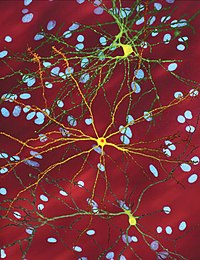
Photo from wikipedia
Huntington’s disease (HD) is a neurodegenerative disorder whose major symptoms include progressive motor and cognitive dysfunction. Cognitive decline is a critical quality of life concern for HD patients and families.… Click to show full abstract
Huntington’s disease (HD) is a neurodegenerative disorder whose major symptoms include progressive motor and cognitive dysfunction. Cognitive decline is a critical quality of life concern for HD patients and families. The enzyme histone deacetylase 3 (HDAC3) appears to be important in HD pathology by negatively regulating genes involved in cognitive functions. Furthermore, HDAC3 has been implicated in the aberrant transcriptional patterns that help cause disease symptoms in HD mice. HDAC3 also helps fuel CAG repeat expansions in human cells, suggesting that HDAC3 may power striatal expansions in the HTT gene thought to drive disease progression. This multifaceted role suggests that early HDAC3 inhibition offers an attractive mechanism to prevent HD cognitive decline and to suppress striatal expansions. This hypothesis was investigated by treating HdhQ111 knock-in mice with the HDAC3-selective inhibitor RGFP966. Chronic early treatment prevented long-term memory impairments and normalized specific memory-related gene expression in hippocampus. Additionally, RGFP966 prevented corticostriatal-dependent motor learning deficits, significantly suppressed striatal CAG repeat expansions, partially rescued striatal protein marker expression and reduced accumulation of mutant huntingtin oligomeric forms. These novel results highlight RGFP966 as an appealing multiple-benefit therapy in HD that concurrently prevents cognitive decline and suppresses striatal CAG repeat expansions.
Journal Title: Scientific Reports
Year Published: 2017
Link to full text (if available)
Share on Social Media: Sign Up to like & get
recommendations!